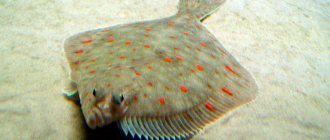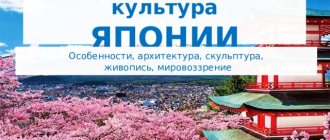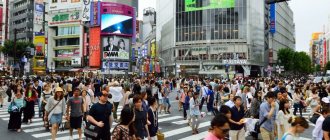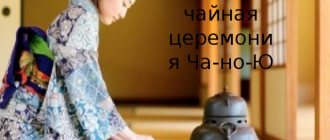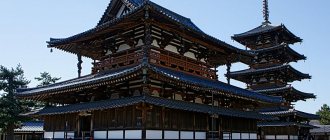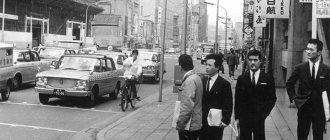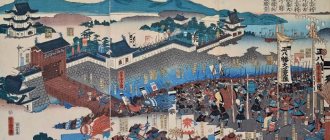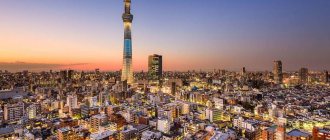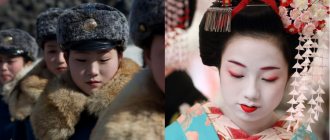- Reports and messages
- Geography
- Japan
Japan is a group of 6,800 islands (the Japanese Archipelago) located in eastern Asia.
Despite its relatively small size (377,000 km²), this country ranks 10th in the world in terms of population. If you come to northern Japan in winter, don't worry about slipping. There is practically no ice there, because all the sidewalks are heated.
In Japan, for every 2,500 people, there is one who celebrated his centenary. These are the highest rates in the world, because the average life expectancy in this country is 84 years.
Japanese trains are the most punctual in the world. If no emergency has occurred, the train will depart on average for no more than 18 seconds. They are also the fastest in the world, trains can reach speeds of up to 603 km/h.
Statistics show that the Japanese love to have pets. There are almost 20 million of them in the Land of the Rising Sun. This is like the entire population of Romania!
If you come to Japan, don’t faint at the sight of square watermelons. Residents of this country will no longer be surprised by such a form. It’s just that smart Japanese entrepreneurs decided to make the packaging and transportation of these berries more convenient.
In Japan, almost all streets are nameless. To avoid getting lost, use block numbers.
If it suddenly started to rain in Japan and you didn’t take an umbrella, don’t be upset. If you find flowerpots with umbrellas, take it. Don't be afraid, you won't steal anything, this item is presented specifically for the forgetful.
Studying in Japan begins on April 1 and is divided into trimesters rather than semesters.
Okunashima Island has become very popular among tourists. It's all about the wild rabbits that roam freely around the island.
Japan is also famous for its unusual and ancient genre of poetry - haiku. This is a genre that contains three unrhymed lines. The most important thing in it is considered to be the hidden meaning.
Japan Post Report
In the 1st century BC. Until the 3rd, the Japanese tribes gradually began to unite together. The Yamato tribe, the 1st dynasty of emperors, took supremacy over the tribes.
Until 710, there was no permanent capital in Japan due to the fact that each subsequent emperor, along with his retinue, moved to a new place according to Shinto customs - it was impossible to live where the previous emperor was buried. In 710, the capital of Heijō-kyō was established. In the 9th century, Japan stopped all contact with China (China had previously been the standard for the life of the Japanese), which gave it impetus for independent development in all spheres of life (from home life to religion).
In the 12th century, dual power was established - the emperor controlled external traditions, but the basic right to govern the country remained in the hands of the military (shoguns).
In 1274, after conquering China, the Mongols decided to seize Japanese lands. They almost managed to do this, but a typhoon that covered the coast of the islands smashed their fleet into pieces. In 1281, a second attempt by the Mongols to capture Japan also failed - a typhoon again destroyed their fleet.
Muromachi period
In 1333 there was a division of power. The incumbent Emperor Godaigo escapes the capital of Kyoto and establishes a new capital in Yoshino, creating the Southern Court. At this time, Shogun Ashikaga becomes emperor in Kyoto and establishes the Northern Court. From that moment on, 2 emperors tried to rule the country. However, due to constant wars between other military clans, both Ashigaka and subsequent emperors from his clan did not have full power. As a result, in 1447 the Ashigaka clan was overthrown and the capital Kyoto was destroyed. Having lost their center of power, each military clan began to impose its own rules on its subject territories. From that moment on, the feudal fragmentation of the country began, which lasted 100 years.
Europeans began to establish contact with Japan - the first firearms were imported, and an attempt was made by missionaries to convert the Japanese to Christianity.
Azuchi-Momoyama period
In 1573, the last shogun of the Ashikaga clan was expelled. The period of feudal fragmentation was over, and from that moment on, under the leadership of Oda Nabunaga, the unification of the lands began. After the death of Nabunaga, the unification of lands was continued by Toyotomi Hideyoshi. He banned monks and peasants from having weapons, forced samurai to become city dwellers, conducted the first census, and banned Christianity. He tried to conquer Korea and China, but suddenly died and the military campaign against these countries automatically stopped. Until the 20th century, Japan did not attack other states in its first war.
Edo period
In 1603, shogun Tokugawa Ieyasu came to power and completed the unification of the clans into a single country. He created a 5-class system, according to which the population was divided into samurai, artisans, merchants, peasants and eta. This one is the Japanese who did the most obscene and humiliating work. Under Tokugawa rule, a period of calm and peace began. The revolt that the peasants tried to raise under the slogans of Christianity was quickly suppressed. From that moment on, a decree was signed that prohibited Europeans from entering Japanese lands. The country's voluntary self-isolation has begun. But in 1853, the American officer Parry forced the Japanese to open the way for trade. The dissatisfaction of the country's residents with self-isolation and many other problems led to the shogun being overthrown from the throne, and power passed into the hands of the emperor.
Meiji period
The new emperor makes the city of Tokyo the main city of Japan. An intensive transformation of the country began: class inequality was abolished, freedom of religion was declared, and compulsory primary education was introduced. The country has completely opened its doors to foreigners - student exchanges have begun. In 1889, the country's first Constitution was adopted.
A war began with Russia, where it eventually wins and expands its territorial borders. Annexes Korea.
World War 2
In 1937, the Sino-Japanese War began. It ended in 1945 with the defeat of Japan. Immediately after the war, the United States carried out its first nuclear weapons attack on humans, dropping bombs on Hirashima and Nagasaki. The country was in distress. The United States took advantage of this and carried out reforms in Japan: a new Constitution was adopted, which abolished the country's armed forces.
In 1952, Japan, according to the Peace Treaty, freed itself from US occupation and began to restore ties with the Soviet Union and China. The country's economy began to boom.
2nd, 3rd, 4th grade, the world around us, briefly
Report on Japan
A short report about Japan will tell you about the eastern land of the rising sun. This country beautifully combines modernity and tradition. This is what attracts a large number of tourists to it.
Brief message about Japan
The message about Japan should begin with the fact that this island state is the easternmost and is washed by the Sea of Okhotsk, Japan and South China.
In what part of the mainland is Japan located?
The island nation of Japan is located in the Pacific Ocean, east of the Sea of Japan, South and North Korea, China and Russia. It occupies an area in the north from the Sea of Okhotsk to Taiwan and the East China Sea in the south. It consists of 6852 islands. The largest of them are Hokkaido, Shikoku, Honshu and Kyushu. They make up about 97% of the total area of the state.
Relief of Japan
The island state is covered with highlands, medium-high and low mountains. They account for more than 75% of the total territory of the country. The lowlands are represented by separate areas that are located along the coasts. The largest lowland is Kanto, with an area of 17,000 km².
Hokkaido is the main ridges of the country, which stretch back to the Kuril Islands and Sakhalin. They stretch along the country from northeast to southwest and from north to south. The highest point is Mount Asahi with an altitude of 2290 m.
Medium-altitude mountains are divided among themselves by basins and valleys. Some are topped by active volcanoes. The highest volcano in Japan is Fuji, located on the island of Honshu. The tops of most mountains are covered with snow. The largest Kinki plain is located in the southwest of the country. But all the islands of Japan are predominantly mountainous. For example, low mountains and plateaus predominate in the Ryukyu Islands.
Minerals of Japan
The island nation has virtually no mineral resources. Sulfur, coal, gold and silver, mercury, lead and zinc, copper and chromium, iron and manganese are mined here. Of course, these reserves are not enough for industrial needs, so most minerals are imported from foreign countries.
Climate of Japan
Japan is classified as a temperature zone that has 4 seasons. Therefore, its climate varies with low temperatures in the north and subtropical temperatures in the south. It also depends on seasonal winds, which blow in the direction from the continent in winter, and in the opposite direction in summer.
There are 6 climate zones:
- Hokkaido. Belongs to an area with low temperatures. Characterized by frosty, long winters and cool summers.
- Japanese Sea. In this zone, the seasonal northeast wind brings heavy snow in winter. In summer it is also not very warm here, but on rare occasions very high temperatures are observed in the Sea of Japan area due to the Föhn phenomenon.
- Central Highlands Zone. It has a typical island climate with large temperature differences between day and night, summer and winter.
- The Japan Inland Sea area has a temperate climate as the mountains in the Shikoku and Chugoku regions block seasonal winds.
- In the Pacific Ocean zone, winters are quite cold and snowfalls are rare. Summer during the seasonal southeast wind period is humid and hot.
- The zone of the southwestern islands has a subtropical climate - hot summers and warm winters. There is a lot of precipitation here, followed by typhoons and rains.
Major rivers and lakes of Japan
The largest rivers in Japan: on the island of Honshu - Shinano, Kitakami, Tone, Ten-ri, Mogami; on the island of Hokkaido - Teshio, Ishikiri, Tokachi; on the island of Shikoku - Yoshino.
The largest lake in the state is Biwa.
Capital of Japan and big cities
The capital is Tokyo.
The largest cities are Kyoto, Yokohama, Nagasaki, Nagano, Sapporo, Hiroshima.
The country's population is more than 127 million people
Natural areas of Japan
There are several natural zones in Japan:
- In the north of the state there is taiga
- Mixed forests
- Broadleaf forests
- Subtropical forest
- Tropical rain forest
- Altitudinal areas
Fauna and flora of Japan
The fauna of Japan contains:
- about 270 species of mammals:
- about 800 species of birds
- 110 species of reptiles.
- there are more than 600 species of fish in the seas
- more than 1000 species of mollusks.
The fauna is dominated by reptiles. The flora includes 700 species of trees and shrubs, about 3000 species of herbs. On about. Hokkaido is dominated by coniferous forests (spruce, fir). In the southern regions (oak, beech, maple, walnut and other trees).
Industry of Japan
The coal mining industry is of greatest importance. Natural gas production has begun.
Japan ranks second in the world in aluminum production. Mechanical engineering is one of the industries that is developing at a rapid pace. Instrument making and the production of precision instruments and mechanisms have undergone significant development. Many household appliances are produced and used all over the world. Japan ranks first in the world in shipbuilding and ship exports.
Japan is one of the leading countries in scientific research such as high technology, biomedicine and robotics. Japan ranks first in the production and use of robots.
The island state has many interesting places, temples, and ancient castles. Places worth visiting - Calligraphy Museum, National Museum, National Museum of Western Art, Meiji Shrine Treasury Museum, Japanese Folk Art Museum, Nijo Castle, Katsura Palace. As well as many imperial tombs, Japanese gardens and shrines.
We hope that the report on Japan helped you learn more about this country and prepare for the lesson. And you can leave your story about Japan through the comment form.
Popular message topics
- The work of Oleg Efremov
Speaking about Ivan Antonovich Efremov, it should be said that this man had absolutely encyclopedic knowledge and from this point of view he was the successor of that series of outstanding - Chemistry in human life
How many schoolchildren sit until the morning reading chemistry textbooks, swearing at the whole world and not understanding why they need it. But once they understand how closely their lives are connected with this field of science, their interest awakens. - Wood mouse
There are many species of rodents around the world, including about 100 species of mice. The most common of them are field, forest and house mice. They are all very similar, but still have differences. This report
Culture
The culture of the Japanese was greatly influenced by the country's geographical location, climate, frequent earthquakes and typhoons. The Japanese identified nature with a living being.
They assigned it a leading role in painting - kaiga.
Japanese is one of the most difficult languages to learn.
A popular poetic form in Japan, haiku is a genre of lyric poetry. Famous representative of the genre Matsuo Basho:
“A stork’s nest in the wind.
And underneath - beyond the storm -
Cherry is a calm color.”
Sculpture in Japan is mainly represented by Buddha statues. One of the oldest is Amitabha, carved out of wood.
The most famous type of Japanese theater is kabuki. All roles are played by men.
Popular animation is anime, which is a film adaptation of manga (Japanese comics).
Sleeping device Сheero sleeping
Insomnia is a real scourge of our time; both adults and, unfortunately, even children are susceptible to it. If the baby is too active and does not want to go into the arms of Morpheus, it is worth turning on this Japanese “sleep aid” for him - if, of course, you can find it outside the country of origin.
© digitaltrends.com
The device, laconic in shape, will fit into any interior. This is also a night light - it emits a soft and pleasant light, reminiscent of the Moon or candles, and produces soothing sounds that induce sleep. It is also a fragrance - as a result, the air becomes fresh and the atmosphere becomes soothing. The device is popular in the Land of the Rising Sun, but is practically unknown in other countries.
